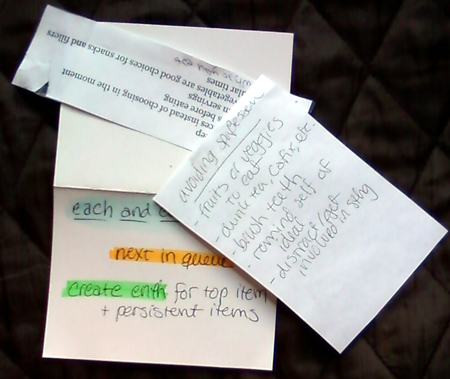Willpower as a series of choices
The real challenge of willpower often comes down to making good choices–a lot of them. One of the best ways to make a good choice is to come to a decision before you actually need to act: for instance, making firm plans to start cleaning out the closet at 3:00pm (ideally with an alarm or reminder in place) instead of coming to an opportunity to start and deciding between that and watching TV; or planning and packing meals for the day rather than choosing something to eat after you’re already hungry.
But for the choices that come up without planning, there are many other tools we can use. As opportunities or temptations come up, we can take time to envision accomplishing a current goal (visualization), focus on immediate positive benefits of a good choice, look for broken ideas, use distraction to steer away from a temptation, or focus on the mechanical steps of acting well (for instance, see my post called “Just Don’t It“)–to name a few techniques.
Seizing the moment
What’s tricky about this is that bringing these tactics to mind takes special focus and a little time, commodities that are often in short supply when there’s an immediate choice to be made. If we wait to figure out what we can do about the situation, often by the time we are recollecting how to detect broken ideas or have come up with a good visualization to use, the opportunity has passed, the doughnut is already being eaten, or the procrastination has already begun.
The solution to this is to develop a protocol, a set of steps to follow every time you possibly can when a choice comes up that requires willpower.
How to create a protocol for choices
A protocol is short list of pithy reminders about willpower tactics: 3 to 4 items is good. It should contain the techniques you think have the best chance of getting you on track on short notice, summarized in a way you can memorize and bring to mind immediately when a situation comes up.
Once you think of your protocol, don’t hesitate: apply the first technique. If that gets you to the good choice you want to make you’re all set, but if it doesn’t seem to be working, switch to the second technique. No single technique is likely to work all the time, which is why having several already thought out is so powerful. Having too many, though, begins to get difficult to remember and hard to apply. Your protocol can swap out elements over time, but try not to overload it.
It can help to include both high-power techniques that require some time and attention and quick-draw techniques that you can apply immediately, since you want to have the big guns available but may not always have the time to deploy them.
Some examples
Protocol elements should be stated in a positive, encouraging, brief way. They should always be directed to plug into your motivation and long-term happiness and never to inspire guilt or to try to force yourself to do something you know you don’t want to do. Rather, these elements should redirect your thinking so that your actual desires in the moment change to make you want to pursue the best choice. There are many such techniques on this site. Here are a few examples. The terms in quotes are the kind of thing you might memorize, while the rest is just explanation. Your protocol elements might be much more specific to your goal than these general examples.
- “What am I thinking?” – Search for broken ideas and repair them: see “All About Broken Ideas and Idea Repair“
- “Just go ahead” – Focus on the mechanical steps of doing the thing you want to do. If the task at hand is making a telephone call you’ve been avoiding, go through the moment-to-moment tasks of looking up the telephone number and dialing each digit instead of trying to get up enthusiasm. If it’s to stop eating, focus on moving your dishes to the sink, closing food containers, putting things away, washing up, walking into the next room, etc.
- “Picture finishing it” – Use visualization to get some immediate happiness out of a long-term goal.
- “Write it out” – Use a feedback loop to reorient yourself.
There are many more techniques you could use in a protocol, and I’ll see if I can’t get together a reference page of them to help. In the mean time, try browsing the complete post listing for this site, where you’ll find articles on a wide variety of willpower tools.
Photo by blythe83





